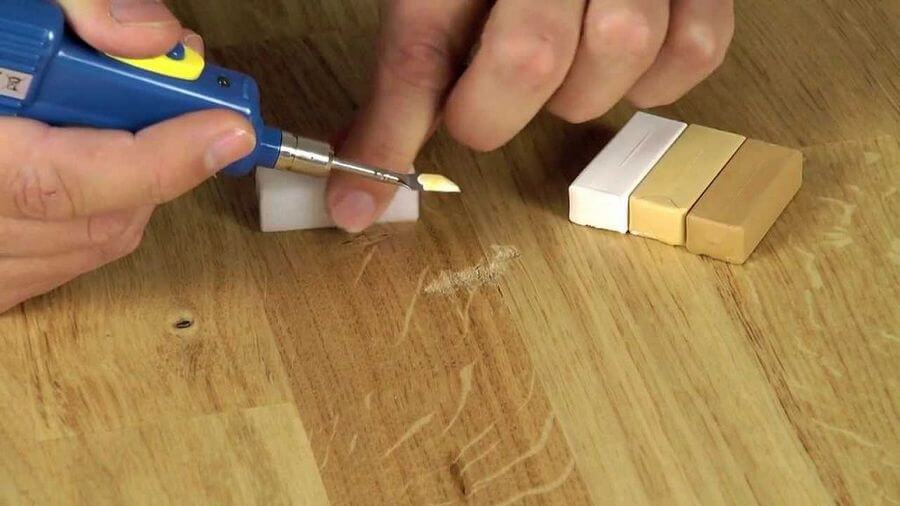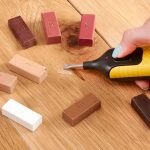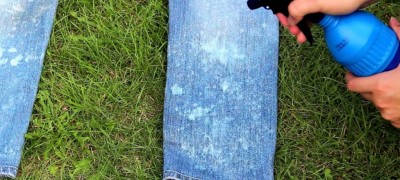How to repair laminate flooring from scuffs, scratches or chips
Laminate is one of the most demanded floor coverings today. And, despite the fact that this material is coated with a wear-resistant compound, over time, scratches and scuffs appear on the surface, which spoil the appearance of your floor. Is there anything you can do to extend the life of your laminate?

Causes of damage
If the laminate is damaged, the situation can be corrected in two ways: either replace the lamella, or restore it using special compounds. Replacement is a laborious method, and not suitable for everyone. Therefore, let's take a closer look at the restoration.

So, the restoration begins with the selection of a suitable concealer, which will retouch the damage so that it will not be visible at all. Immediately, we note that one hundred percent removal of scratches on the laminate is impossible, since it is not an array, but a multilayer material. The upper decorative part of the laminate is paper, printed on it, and covered with a layer of thermosetting resin. Therefore, only holes or chips are ideally removed. Scratches can only be carefully retouched.

Important: as soon as you notice damage on the surface, you need to immediately take measures to eliminate them. After all, scratches not only spoil the appearance, but also allow the coating to deteriorate further.
The damage can be small or large. Small ones often appear due to abrasive particles (sand, for example), and are not immediately noticeable. And it is very simple to eliminate such defects, and usually the means available for any housewife are used for repairs.
Large defects can appear due to pets, which leave marks with their claws. Also, dents and chips remain after rearranging furniture, or when walking in heels.
Minor scratches and abrasions
These are the most "harmless" injuries. If desired, you can deal with them with improvised means. In particular, olive oil is widely used. Of the specialized products, it is worth noting polish and universal aerosol lubricant.

Before proceeding with the processing of any of the above compounds, the surface should be well cleaned of dust.
Olive oil
For the "procedure", in addition to olive oil, you will need water, a floor detergent, a cloth with high hygroscopicity, and a dry soft cloth.

First, the floor is washed with water and shampoo. After that, it is wiped dry, especially in the places of subsequent restoration. The oil should be rubbed directly into scratches. And it is not enough just to apply olive oil to the damaged area. It is important to carefully polish the area where the scratch was. The result becomes more noticeable after about half an hour.

Polish
These special formulations are available in household chemical stores. They are available as mastic, liquid or aerosol. Be sure to read the instructions! It should be written there that the product is intended specifically for the laminate. Any other polish will leave indelible stains on laminated parquet flooring.

Liquid products are used in much the same way as floor cleaning compounds. They are simply added to the water and wiped off the surface. In addition to restoring damaged areas, such polishes leave a protective layer on the laminate, and it prolongs the life of the coating.

Mastic is a rather thick substance. In terms of efficiency, it is superior to liquid polishes. With the help of mastic, you will not only mask scratches and scuffs, but also give the laminated parquet its original shine. The mastic is rubbed into the laminate in a circular motion, wait a certain time (usually everything is detailed in the instructions), and wipe the floor with a dry soft cloth.

Aerosol polishes are sprayed onto the damaged area and then rubbed onto the surface. Finally, the laminate is polished.
Universal grease WD-40
This composition, which is especially popular among car owners, is indispensable for repairing minor damages on laminated parquet flooring. The procedure is as follows: spray on the damaged area, wait a few minutes, clean the treated surface with a soft brush.

Any of the above tools will cope with minor damage. But if you need to fix deep scratches and cracks, the solutions will be very different.
Deep scratches and damage
If you had the negligence to parade on the laminate in heels, or during the next rearrangement did not take care of the careful "movement" of furniture, deep damage to the laminate is guaranteed to you. And, unfortunately, the problem is not only in the lack of aesthetics, but also in the fact that the parquet floor can begin to deteriorate further. First, water will enter through the damaged surface (for example, a chip) during wet cleaning. Over time, the lamellas will swell and rot from the inside.

Wax chalk
A laminate pencil or wax crayon is one of the most common ways to deal with damaged laminate flooring. First, the floor is washed well using a special detergent. Then let it dry. After that, the scratches are “painted over” with wax crayon across the damage. Finally, the restored area is polished with a dry soft cloth.
If the damage is very deep, the procedure will have to be repeated more than once. As a rule, if the color of the chalk is suitable, the restoration will be completely invisible to the prying eye.
Another advantage of a wax crayon is that it has an almost unlimited shelf life. This means that such a tool can be purchased for future use, just in case. Moreover, it is inexpensive and does not require the use of additional tools for the restoration of the laminated surface.

Laminate restoration paste
The wax crayon mentioned above is the ideal solution for medium to moderate damage. If you need to resolve the issue with the restoration of deep damage - the restoration paste is definitely your story.
Such a paste is sold in specialized stores, and its use requires certain skills. So, before proceeding with the repair of parquet in a conspicuous place, it is better to practice on an unnecessary board.

The paste is applied strictly to the damage; the mixture should not protrude beyond the edges of the break. If this happens, you need to remove the excess paste as soon as possible so that they do not have time to freeze. After applying to the scratch, it should be left on for about 1 hour. After the paste has dried, it is better to cover the restored area with a special varnish. It will be more aesthetically pleasing and will extend the life of the laminate.

Acrylic varnish and plaster
Perfect repair of damage on a glossy floor is guaranteed by an acrylic-based varnish. First, the floor is washed well with a special product. Then, with a small brush, varnish is applied to the damaged area, allowed to dry, and then the surface is polished.
With plaster, the process is more complicated, but in case of deep damage, this remedy has no worthy alternative. In other words, only plaster will mask severe abrasions and chips.

For work you will need:
- Water;
- Gypsum;
- Sawdust;
- A small piece of wood that matches the color of the laminate flooring.
The damaged area is cleaned of dust and dirt. While the laminate is drying, the sawdust is mixed with gypsum in a 1: 1 ratio. A little water is added and stirred until the consistency of a thick, homogeneous paste. With a small spatula or a knife with a narrow blade, the mixture is put into the crack, and a piece of wood is applied on top to mask the defect. It is left to dry completely.

If gypsum was not at hand, and repairs are urgently required, then PVA glue can be mixed with sawdust. In this case, no water needs to be added. The rest of the work steps are exactly the same as with plaster.
So, it is obvious that the answer to the question: how to remove scratches from a laminate, or how to restore deep damage - exists. And often expensive materials are not required for restoration. All formulations can be purchased in household chemicals stores within walking distance. And your neatness and attentiveness will guarantee a quality repair.

Video: how to remove scratches on a laminate













